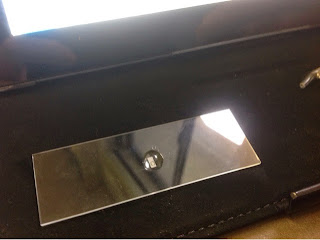The Compound Microscope Lab
In this lab, we experimented with compound microscopes by looking at different materials. We began our experiment by looking at different letters from a newspaper. After finding the letter and cutting it out, we placed it a drop of water and sandwiched it in between sides. The first letter was the letter "O." We changed the different lens objectives and turned the coarse and fine adjustment knobs until we could see the letter clearly. We used the lowest power lens, 4x. Unfortunately, the "O" we choose had a picture on the opposite side, so the image was dark, with only a faint outline of the letter.
Next, we followed the same procedure, accept with a "C." This time, we made sure to choose a clear letter. The image turned out much better. We then realized that the "C" was flipped and upside-down. After further observation, we realized that the same thing happened with the "O" but it was harder to see. We concluded that microscopes invert the image. We proved this theory by following the same steps with an "e."

Then, it was time to branch off from letters. We started with hairs. I yanked out a handful my of red hair, and put in in a slide along with some black hair in a cross shape. We changed the objective lens to high-power. It was a very dark image. In order to fix this, we experimented by changing the diaphragm, which allowed different amounts of light pass through. The hair looked plastic, and had some tiny bubbles attached to it. We could even see the red hair refracting the black hair, the same effect of a straw in water. We assumed this was because of the hair's cylindrical shape.
We then looked at tiny strands of yarn under the microscope. We could see tiny little frayed pieces of yarn coming off the the larger pieces.
Finally, we placed a ruler underneath the microscope to see how large the field of view is. The diameter was three mm. We could then use this information to measure certain parts of the object that would normally be too small to measure.
Discussion
- The differences between the image in the microscope and the naked eye is that the microscope inverts the image, and of course magnifies it.
- Not all of the object may be in focus when viewed through a high powered objective because the images are not perfectly flat, so the microscope can only focus on one plane at a time.
- The order of the overlapping threads is: Red and blue side-to-side with black on top.
- The relationship between the magnification and the diameter of the field of view is they are inverse: when the magnification increases, the field of view decreases.
- The diameter of the field of view was 3000 micrometers.
- A=100/4 = 25, 3000 micrometers divided by 25 = 120 micrometers.
- 3000/6500=x/120; x=55.4. My hair was about 55.4 micrometers.






No comments:
Post a Comment